Variability of Marine Particle Size Distributions and the Correlations with Inherent Optical Properties in the Coastal Waters of the Northern South China Sea
Abstract
:1. Introduction
2. Materials and Methods
2.1. Study Area and Sampling
2.2. Optical Properties Measurements
2.3. PSD Acquisition
2.4. Analysis of PSD with Respect to IOPs
2.5. Performance Matrix
3. Results
3.1. Inherent Optical Properties and PSD
3.2. Variability of PSD
3.2.1. Variability of PSD in Surface Water
3.2.2. Vertical Variability of PSD
3.3. The Correlations between PSD and IOPs
3.3.1. IOPs vs. SPM, VC, NC, and AC
3.3.2. Mass-Specific IOPs vs. DA, ρa, and ρaDA
3.3.3. Volume-Specific IOPs vs. DA and Percentile Diameters
4. Discussion
5. Conclusions
Author Contributions
Funding
Acknowledgments
Conflicts of Interest
Abbreviations
| Variables or abbreviations | Description |
| apg | Non-water absorption coefficient |
| A(D) | Cross-sectional area concentration of particle |
| AC | Total cross-sectional area concentration of particle |
| bbp | Backscattering coefficient of particle |
| bbp/SPM | Mass-specific backscattering coefficient of particle |
| bbp/VC | Volume-specific backscattering coefficient of particle |
| bp | Scattering coefficient of particle |
| bp/SPM | Mass-specific scattering coefficient of particle |
| bp/VC | Volume-specific scattering coefficient of particle |
| cp | Attenuation coefficient of particle |
| cpg | Non-water attenuation coefficient |
| cp/SPM | Mass-specific attenuation coefficient of particle |
| cp/VC | Volume-specific attenuation coefficient of particle |
| D | Volume-equivalent spherical diameter |
| DA | Mean particle diameter weighted by area |
| Dv50 | Median particle diameter |
| Dv75 | 75th percentile diameter |
| Dv25 | 25th percentile diameter |
| Dv10 | 10th percentile diameter |
| IOPs | Inherent optical properties |
| N(D) | Particle number concentration |
| N’(D) | The density function of the number concentration |
| NC | Total number concentration of particle |
| PSD | Particle size distribution |
| Qbbe | Mean backscattering efficiency |
| SPM | Mass concentration of suspended particle matter |
| V(D) | Particle volume concentration |
| VC | Total volume concentration of particle |
| ξ | PSD slope |
| ρa | Apparent density |
References
- Balasubramanian, S.V.; Pahlevan, N.; Smith, B.; Binding, C.; Schalles, J.; Loisel, H.; Gurlin, D.; Greb, S.; Alikas, K.; Randla, M.; et al. Robust algorithm for estimating total suspended solids (TSS) in inland and nearshore coastal waters. Remote Sens. Environ. 2020, 246, 111768. [Google Scholar] [CrossRef]
- Runyan, H.; Reynolds, R.A.; Stramski, D. Evaluation of Particle Size Distribution Metrics to Estimate the Relative Contributions of Different Size Fractions Based on Measurements in Arctic Waters. J. Geophys. Res. Oceans 2020, 125, e2020JC016218. [Google Scholar] [CrossRef] [PubMed]
- Nasiha, H.J.; Shanmugam, P.; Sundaravadivelu, R. Estimation of sediment settling velocity in estuarine and coastal waters using optical remote sensing data. Adv. Space Res. 2019, 63, 3473–3488. [Google Scholar] [CrossRef]
- Xi, H.; Larouche, P.; Tang, S.; Michel, C. Characterization and variability of particle size distributions in Hudson Bay, Canada. J. Geophys. Res. Oceans 2014, 119, 3392–3406. [Google Scholar] [CrossRef]
- Qiu, Z.; Sun, D.; Hu, C.; Wang, S.; Zheng, L.; Huan, Y.; Peng, T. Variability of Particle Size Distributions in the Bohai Sea and the Yellow Sea. Remote Sens. 2016, 8, 949. [Google Scholar] [CrossRef] [Green Version]
- Reynolds, R.A.; Stramski, D. Variability in Oceanic Particle Size Distributions and Estimation of Size Class Contributions Using a Non-parametric Approach. J. Geophys. Res. Ocean. 2021, 126, e2021JC017946. [Google Scholar] [CrossRef]
- Slade, W.H.; Boss, E. Spectral attenuation and backscattering as indicators of average particle size. Appl. Opt. 2015, 54, 7264–7277. [Google Scholar] [CrossRef]
- Wozniak, S.; Stramski, D.; Stramska, M.; Reynolds, R.; Wright, V.M.; Miksic, E.Y.; Cichocka, M.; Cieplak, A. Optical variability of seawater in relation to particle concentration, composition, and size distribution in the near-shore marine environment at Imperial Beach, California. J. Geophys. Res. Ocean 2010, 115, C8. [Google Scholar] [CrossRef] [Green Version]
- Reynolds, A.R.; Stramski, D.; Wright, M.V.; Woniak, B.S. Measurements and characterization of particle size distributions in coastal waters. J. Geophys. Res. Ocean. 2010, 115, C08024. [Google Scholar] [CrossRef]
- Sun, D.; Qiu, Z.; Hu, C.; Wang, S.; Wang, L.; Zheng, L.; Peng, T.; He, Y. A hybrid method to estimate suspended particle sizes from satellite measurements over Bohai Sea and Yellow Sea. J. Geophys. Res. Ocean. 2016, 121, 6742–6761. [Google Scholar] [CrossRef]
- Bader, H. The hyperbolic distribution of particle sizes. J. Geophys. Res. Earth Surf. 1970, 75, 2822–2830. [Google Scholar] [CrossRef]
- Jonasz, M. Particle-size distributions in the Baltic. Tellus B Chem. Phys. Meteorol. 1983, 35, 346–358. [Google Scholar] [CrossRef]
- Jonasz, M.; Fournier, G.R. Approximation of the size distribution of marine particles by a sum of log-normal functions. Limnol. Oceanogr. 1996, 41, 744–754. [Google Scholar] [CrossRef]
- Risović, D. Two-component model of sea particle size distribution. Deep Sea Res. Part I: Oceanogr. Res. Pap. 1993, 40, 1459–1473. [Google Scholar] [CrossRef]
- Junge, C.E. Air Chemistry and Radioactivity; Academic Press: New York, NY, USA, 1963. [Google Scholar]
- Boss, E.; Twardowski, M.S.; Herring, S. Shape of the particulate beam attenuation spectrum and its inversion to obtain the shape of the particulate size distribution. Appl. Opt. 2001, 40, 4885–4893. [Google Scholar] [CrossRef]
- Neukermans, G.; Loisel, H.; Mériaux, X.; Astoreca, R.; McKee, D. In situ variability of mass-specific beam attenuation and backscattering of marine particles with respect to particle size, density, and composition. Limnol. Oceanogr. 2011, 57, 124–144. [Google Scholar] [CrossRef] [Green Version]
- Kostadinov, T.S.; Siegel, D.A.; Maritorena, S. Retrieval of the particle size distribution from satellite ocean color observations. J. Geophys. Res. Earth Surf. 2009, 114, C9. [Google Scholar] [CrossRef]
- Bowers, D.G.; Binding, C.E.; Ellis, K.M. Satellite remote sensing of the geographical distribution of sus-pended particle size in an energetic shelf sea. Estuar Coast. Shelf Sci. 2007, 73, 457–466. [Google Scholar] [CrossRef]
- van der Lee, E.; Bowers, D.; Kyte, E. Remote sensing of temporal and spatial patterns of suspended particle size in the Irish Sea in relation to the Kolmogorov microscale. Cont. Shelf Res. 2009, 29, 1213–1225. [Google Scholar] [CrossRef]
- Wang, Z.; Hu, S.; Li, Q.; Liu, H.; Liao, X.; Wu, G. A Four-Step Method for Estimating Suspended Particle Size Based on In Situ Comprehensive Observations in the Pearl River Estuary in China. Remote Sens. 2021, 13, 5172. [Google Scholar] [CrossRef]
- Buonassissi, C.J.; Dierssen, H.M. A regional comparison of particle size distributions and the power law approximation in oceanic and estuarine surface waters. J. Geophys. Res. Earth Surf. 2010, 115, C10. [Google Scholar] [CrossRef]
- Jonasz, M.; Fournier, G. Light Scattering by Particles in Water: Theoretical and Experimental Foundations; Academic Press: Cambridge, MA, USA, 2007. [Google Scholar]
- Mie, G. Beiträge zur Optik trüber Medien, speziell kolloidaler Metallösungen. Ann. Phys. 1908, 330, 377–445. [Google Scholar] [CrossRef]
- Zhan, W.; Wu, J.; Wei, X.; Tang, S.; Zhan, H. Spatio-temporal variation of the suspended sediment concen-tration in the Pearl River Estuary observed by MODIS during 2003–2015. Cont. Shelf Res. 2019, 172, 22–32. [Google Scholar] [CrossRef]
- Xu, W.; Yan, W.; Li, X.; Zou, Y.; Chen, X.; Huang, W.; Miao, L.; Zhang, R.; Zhang, G.; Zou, S. Antibiotics in riverine runoff of the Pearl River Delta and Pearl River Estuary, China: Concentrations, mass loading and ecological risks. Environ. Pollut. 2013, 182, 402–407. [Google Scholar] [CrossRef]
- Su, Q.; Li, Z.; Li, G.; Zhu, D.; Hu, P. Application of the Coastal Hazard Wheel for Coastal Multi-Hazard Assessment and Management in the Guang-Dong-Hongkong-Macao Greater Bay Area. Sustainability 2021, 13, 12623. [Google Scholar] [CrossRef]
- Wang, Z.; Kawamura, K.; Sakuno, Y.; Fan, X.; Gong, Z.; Lim, J. Retrieval of Chlorophyll-a and Total Sus-pended Solids Using Iterative Stepwise Elimination Partial Least Squares (ISE-PLS) Regression Based on Field Hy-perspectral Measurements in Irrigation Ponds in Higashihiroshima, Japan. Remote Sens. 2017, 9, 264. [Google Scholar] [CrossRef] [Green Version]
- Zhang, Y.; Shi, K.; Zhou, Y.; Liu, X.; Qin, B. Monitoring the river plume induced by heavy rainfall events in large, shallow, Lake Taihu using MODIS 250m imagery. Remote Sens. Environ. 2015, 173, 109–121. [Google Scholar] [CrossRef]
- Wet Labs. AC Meter Protocol Document (Revision Q); Wet Labs, Inc.: Philomath, OR, USA, 2011. [Google Scholar]
- Sullivan, J.M.; Twardowski, M.S.; Zaneveld, J.R.V.; Moore, C.M.; Barnard, A.H.; Donaghay, P.L.; Rhoades, B. Hyperspectral temperature and salt dependencies of absorption by water and heavy water in the 400–750 nm spectral range. Appl. Opt. 2006, 45, 5294–5309. [Google Scholar] [CrossRef] [Green Version]
- Lin, J.; Cao, W.; Wang, G.; Zhou, W.; Sun, Z.; Zhao, W. Inversion of bio-optical properties in the coastal upwelling waters of the northern South China Sea. Cont. Shelf Res. 2014, 85, 73–84. [Google Scholar] [CrossRef]
- Martinez-Vicente, V.; Land, P.E.; Tilstone, G.H.; Widdicombe, C.; Fishwick, J.R. Particulate scattering and backscattering related to water constituents and seasonal changes in the Western English Channel. J. Plankton Res. 2010, 32, 603–619. [Google Scholar] [CrossRef]
- Wet Labs. Scattering Meter ECO BB9 User’s Guide (Revision L); Wet Labs, Inc.: Philomath, OR, USA, 2013. [Google Scholar]
- Huang, J.; Chen, X.; Jiang, T.; Yang, F.; Chen, L.; Yan, L. Variability of particle size distribution with respect to inherent optical properties in Poyang Lake, China. Appl. Opt. 2016, 55, 5821–5829. [Google Scholar] [CrossRef] [PubMed]
- Lei, S.; Wu, D.; Li, Y.; Wang, Q.; Huang, C.; Liu, G.; Zheng, Z.; Du, C.; Mu, M.; Xu, J.; et al. Remote sensing monitoring of the suspended particle size in Hongze Lake based on GF-1 data. Int. J. Remote Sens. 2018, 40, 3179–3203. [Google Scholar] [CrossRef]
- LISST-200X Particle Size Analyzer: User’s Manual (Version 1.3B); Sequoia Scientific, Inc.: Bellevue, WA, USA, 2018.
- Agrawal, Y.C.; Whitmire, A.; Mikkelsen, O.A.; Pottsmith, H.C. Light scattering by random shaped particles and consequences on measuring suspended sediments by laser diffraction. J. Geophys. Res. Ocean 2008, 113, C4. [Google Scholar] [CrossRef] [Green Version]
- Kratzer, S.; Kyryliuk, D.; Brockmann, C. Inorganic suspended matter as an indicator of terrestrial influence in Baltic Sea coastal areas—Algorithm development and validation, and ecological relevance. Remote Sens. Environ. 2020, 237, 111609. [Google Scholar] [CrossRef]
- Wang, S.; Qiu, Z.; Sun, D.; Shen, X.; Zhang, H. Light beam attenuation and backscattering properties of particles in the Bohai Sea and Yellow Sea with relation to biogeochemical properties. J. Geophys. Res. Oceans 2016, 121, 3955–3969. [Google Scholar] [CrossRef] [Green Version]
- Lin, J.; Lee, Z.; Ondrusek, M.; Liu, X. Hyperspectral absorption and backscattering coefficients of bulk wa-ter retrieved from a combination of remote-sensing reflectance and attenuation coefficient. Opt. Express 2018, 26, A157–A177. [Google Scholar] [CrossRef]
- Reynolds, R.A.; Stramski, D.; Neukermans, G. Optical backscattering by particles in Arctic seawater and relationships to particle mass concentration, size distribution, and bulk composition. Limnol. Oceanogr. 2016, 61, 1869–1890. [Google Scholar] [CrossRef] [Green Version]
- Roy, S.; Sathyendranath, S.; Bouman, H.; Platt, T. The global distribution of phytoplankton size spectrum and size classes from their light-absorption spectra derived from satellite data. Remote Sens. Environ. 2013, 139, 185–197. [Google Scholar] [CrossRef]
- Ye, F.; Huang, X.; Zhang, D.; Tian, L.; Zeng, Y. Distribution of heavy metals in sediments of the Pearl River Estuary, Southern China: Implications for sources and historical changes. J. Environ. Sci. 2012, 24, 579–588. [Google Scholar] [CrossRef]
- Lei, S.; Xu, J.; Li, Y.; Li, L.; Lyu, H.; Liu, G.; Chen, Y.; Lu, C.; Tian, C.; Jiao, W. A semi-analytical algorithm for deriving the particle size distribution slope of turbid inland water based on OLCI data: A case study in Lake Hongze. Environ. Pollut. 2020, 270, 116288. [Google Scholar] [CrossRef]
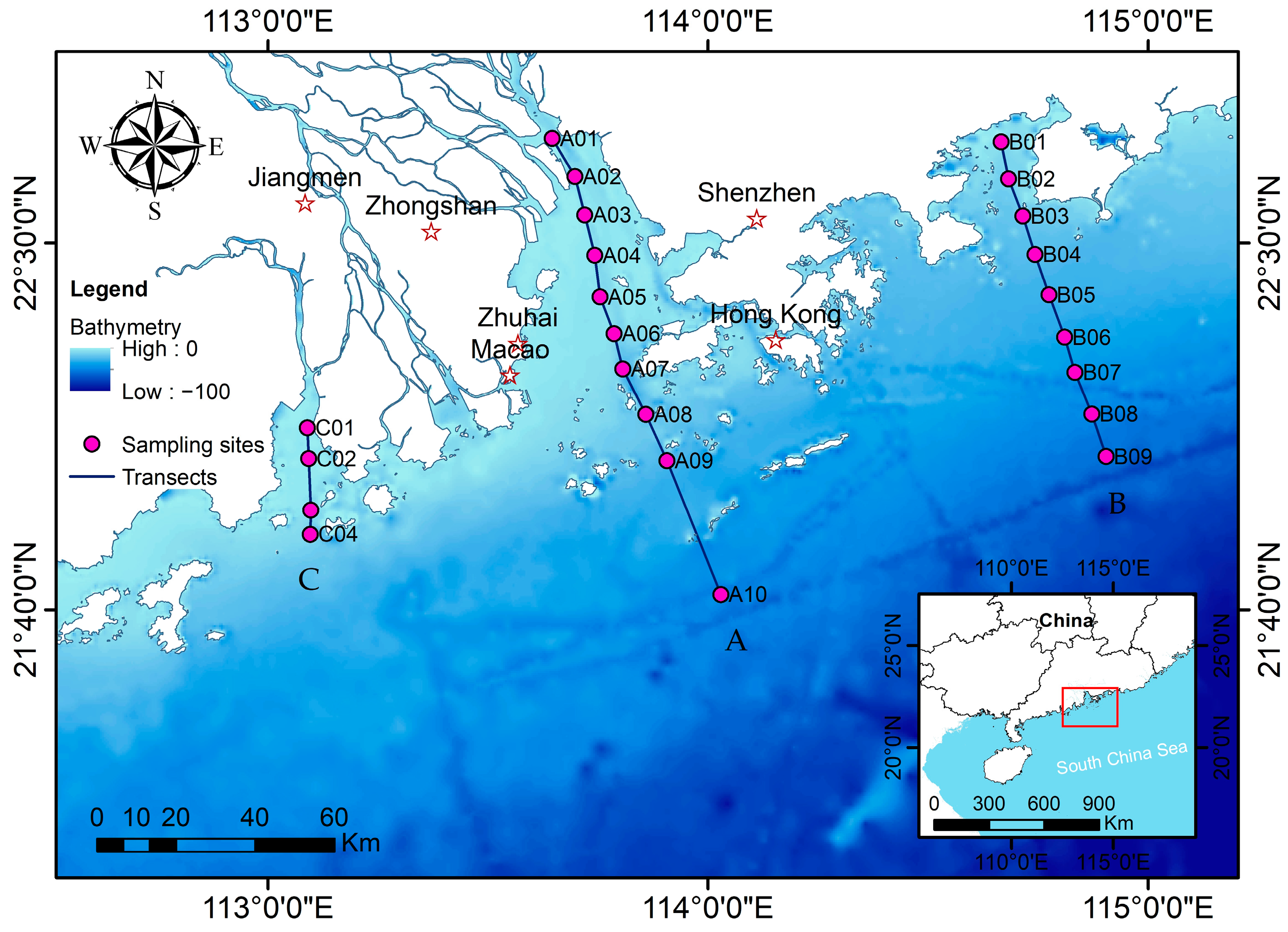
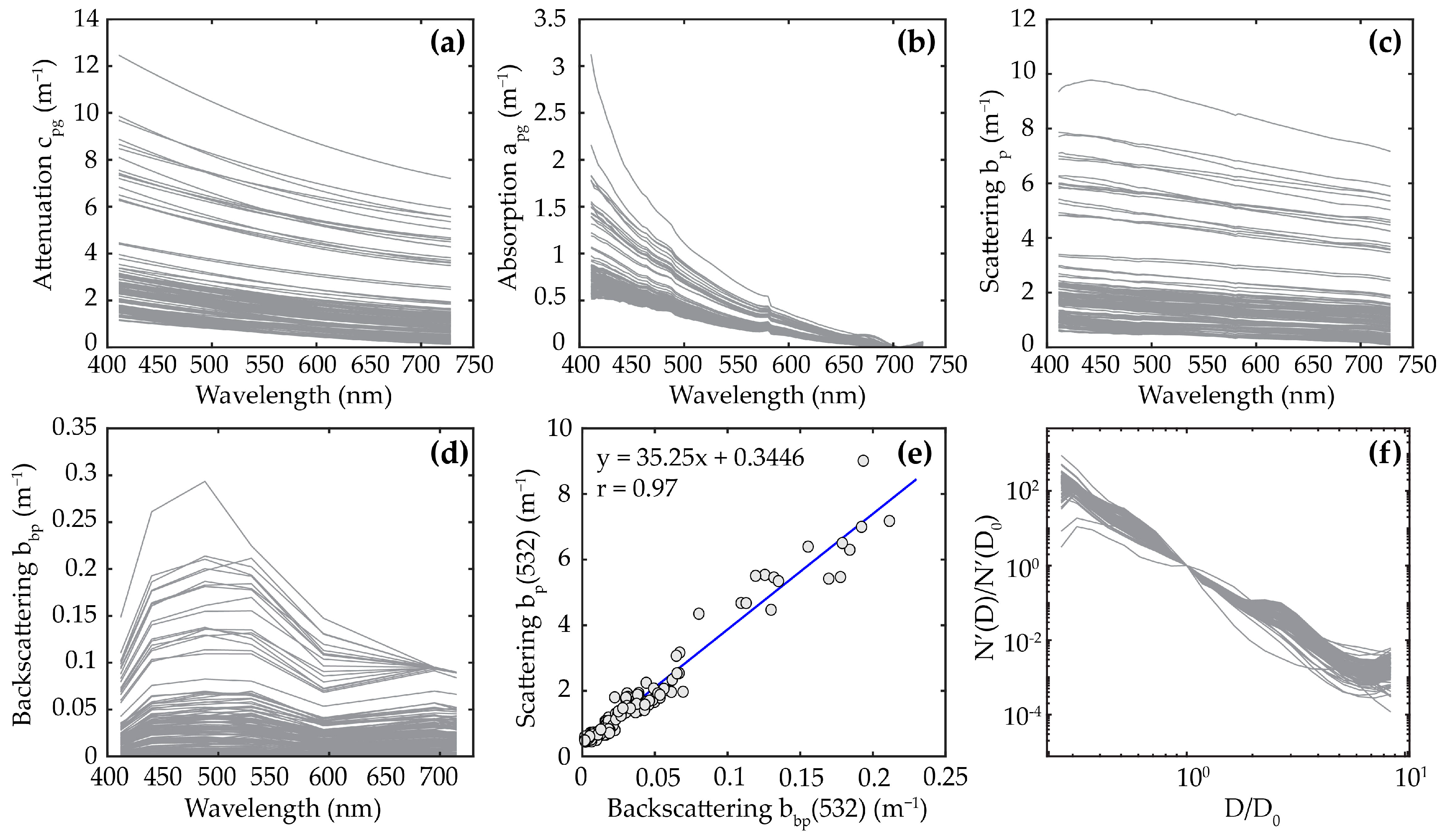


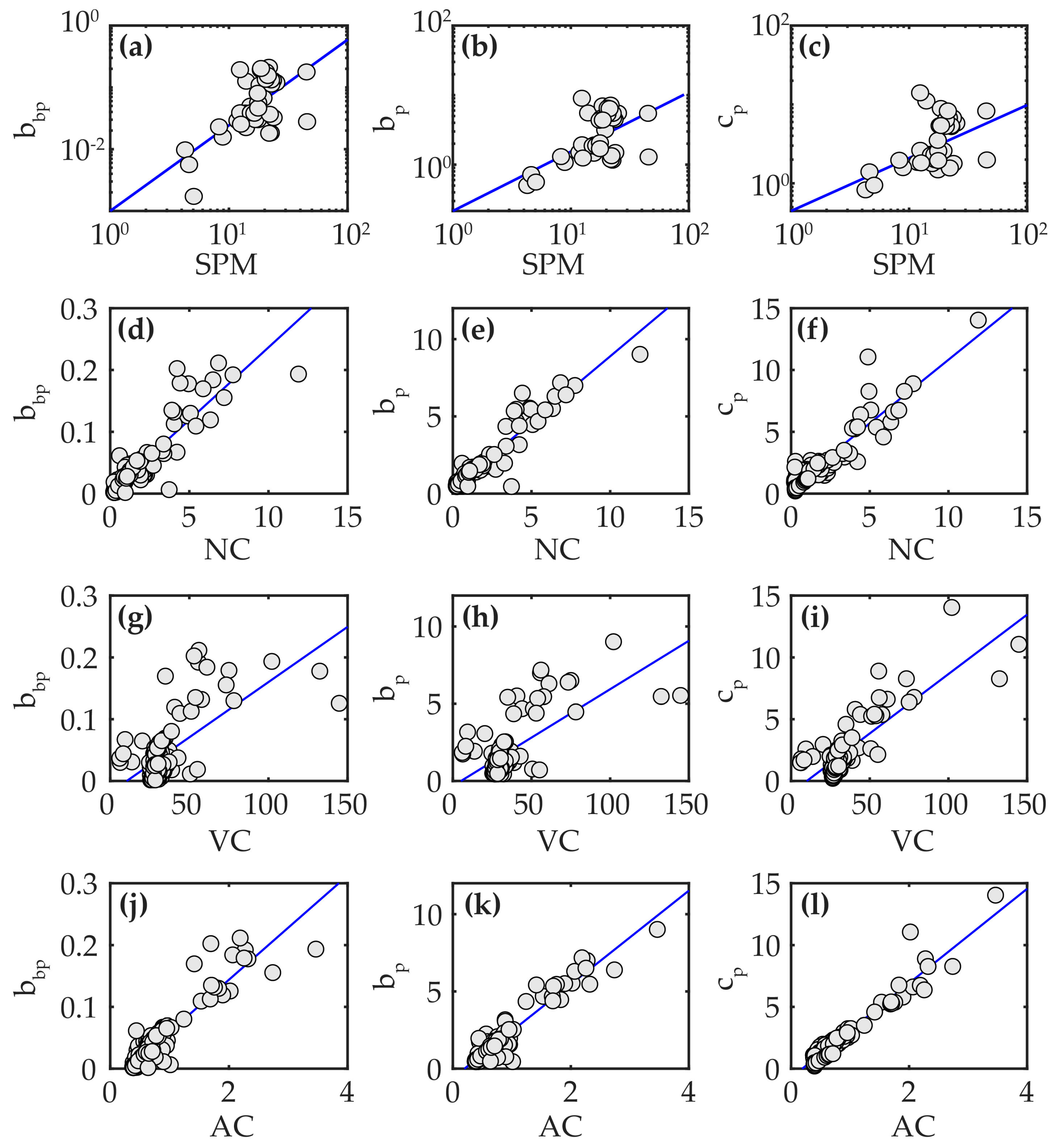
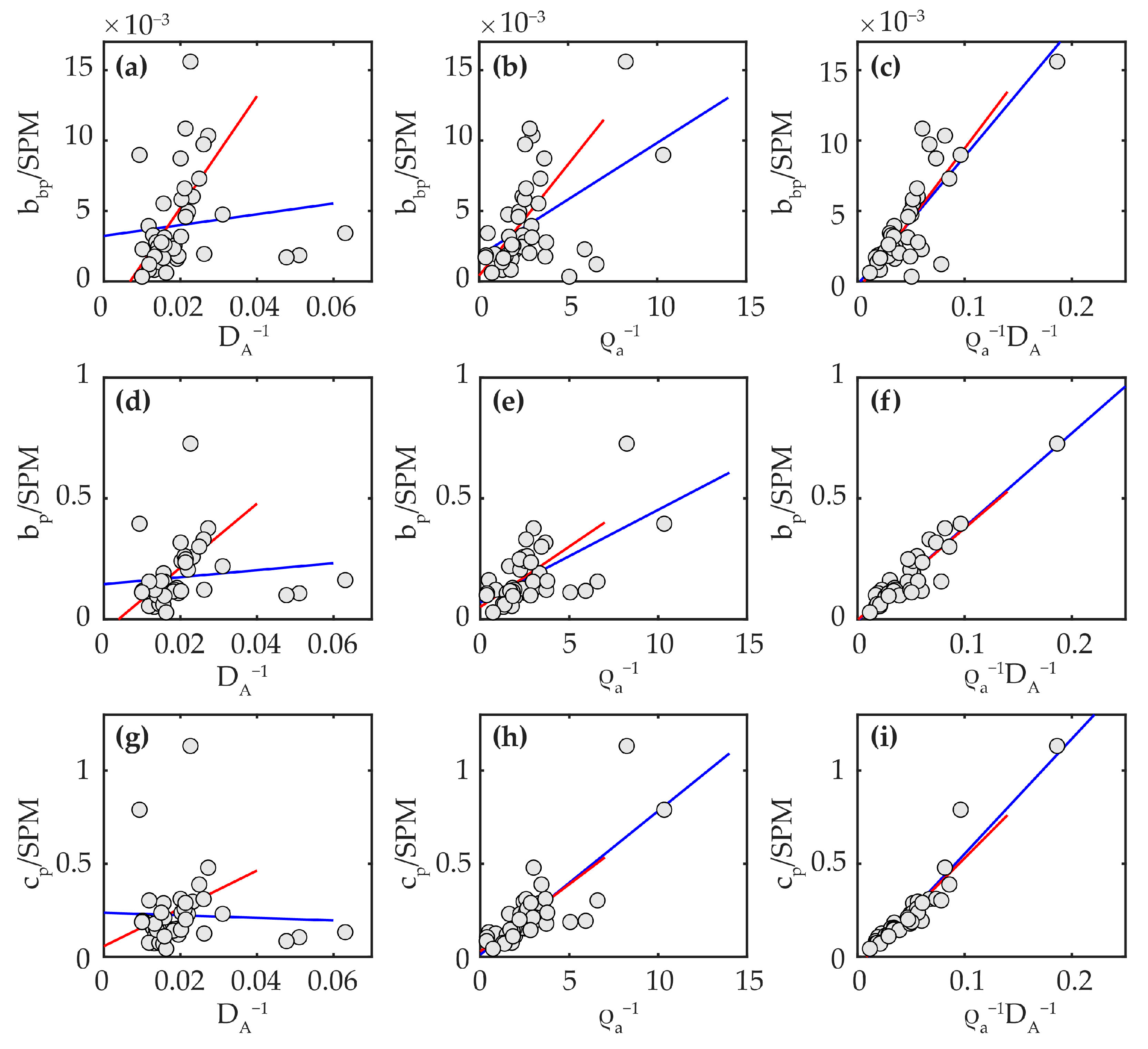
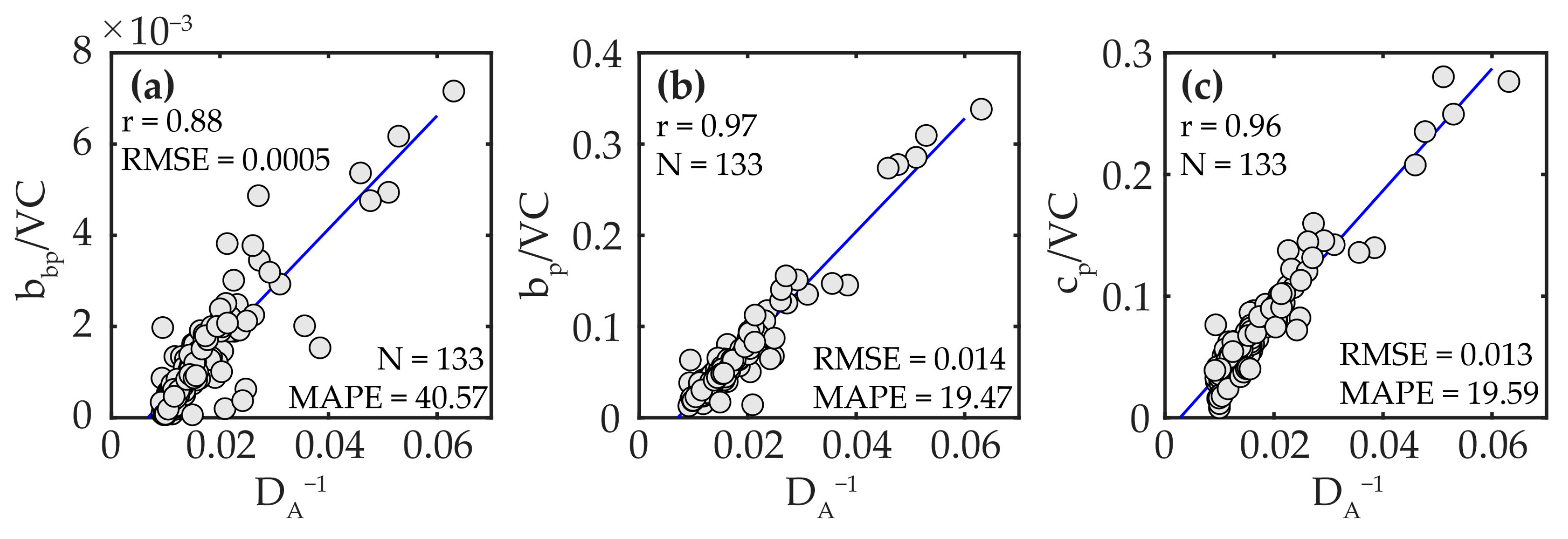
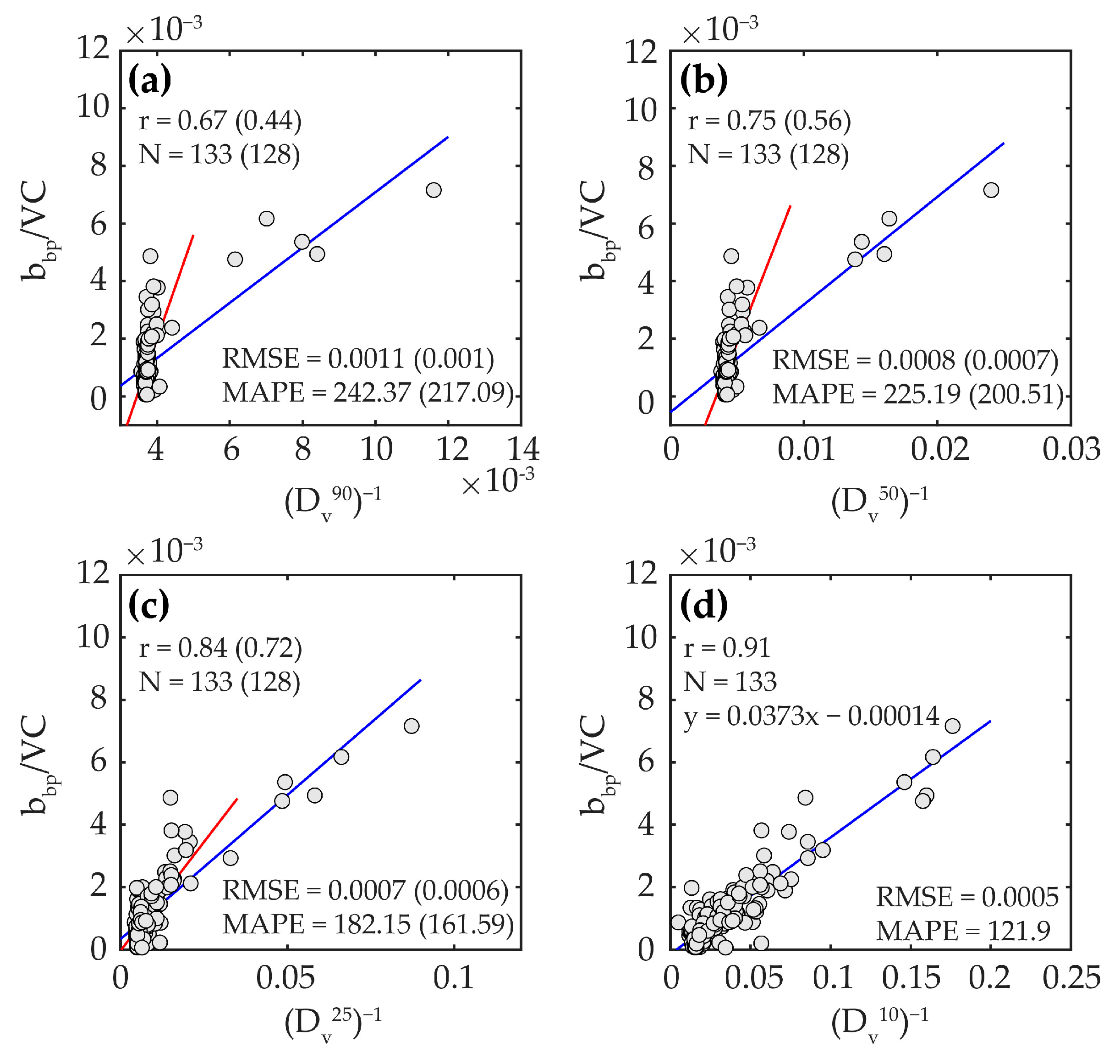
| Variable | Units | Min | Max | Mean | SD | CV (%) | N |
|---|---|---|---|---|---|---|---|
| bbp | m−1 | 0.0017 | 0.2114 | 0.0419 | 0.0481 | 114.89 | 133 |
| bp | m−1 | 0.45 | 9.01 | 1.80 | 1.67 | 93.21 | 133 |
| cp | m−1 | 0.21 | 14.04 | 2.30 | 2.08 | 90.60 | 133 |
| NC | 1010 count m−3 | 0.21 | 11.90 | 1.70 | 1.86 | 109.57 | 133 |
| VC | µL L−1 | 5.96 | 144.76 | 33.84 | 18.10 | 53.49 | 133 |
| AC | m−1 | 0.38 | 3.47 | 0.79 | 0.53 | 66.76 | 133 |
| Dv50 | µm | 41.60 | 263.02 | 227.35 | 37.08 | 16.31 | 133 |
| ξ | none | 2.61 | 3.74 | 3.07 | 0.19 | 6.16 | 133 |
| SPM | g m−3 | 4.28 | 45.60 | 17.99 | 8.08 | 44.88 | 42 |
| bbp/SPM | m2 g−1 | 0.0003 | 0.0156 | 0.0040 | 0.0033 | 83.06 | 42 |
| bp/SPM | m2 g−1 | 0.03 | 0.73 | 0.17 | 0.13 | 71.80 | 42 |
| cp/SPM | m2 g−1 | 0.04 | 1.13 | 0.22 | 0.19 | 87.16 | 42 |
| bbp/VC | 106 m−1 | 0.0001 | 0.0072 | 0.0012 | 0.0013 | 102.12 | 133 |
| bp/VC | 106 m−1 | 0.01 | 0.34 | 0.06 | 0.06 | 99.00 | 133 |
| cp/VC | 106 m−1 | 0.01 | 0.28 | 0.07 | 0.05 | 67.85 | 133 |
| DA | μm | 15.85 | 107.43 | 58.94 | 21.17 | 35.92 | 133 |
| ρa | kg L−1 | 0.10 | 2.79 | 0.61 | 0.59 | 97.49 | 42 |
| ρa DA | g m−2 | 5.37 | 86.18 | 28.96 | 16.25 | 56.09 | 42 |
| IOPs | Concentrations | r | Slope (SE) | Incept (SE) | RMSE | MAPE | N |
|---|---|---|---|---|---|---|---|
| bbp | SPM | 0.64 | 1.3853 (0.2646) | −6.9059 (0.7488) | 0.094 | 102.71 | 42 |
| NC | 0.91 | 0.0235 (0.0009) | 0.002 (0.0024) | 0.022 | 32.42 | 133 | |
| VC | 0.67 | 0.0018 (0.0002) | −0.0186 (0.0066) | 0.036 | 107.05 | 133 | |
| AC | 0.92 | 0.0843 (0.0031) | −0.0246 (0.0029) | 0.018 | 40.2 | 133 | |
| bp | SPM | 0.55 | 0.854 (0.2039) | −1.5342 (0.5772) | 12.44 | 153.14 | 42 |
| NC | 0.95 | 0.8541 (0.0248) | 0.3465 (0.0624) | 0.53 | 15.86 | 133 | |
| VC | 0.68 | 0.0627 (0.0059) | −0.3236 (0.2280) | 1.23 | 122.38 | 133 | |
| AC | 0.95 | 3.0294 (0.0838) | −0.5946 (0.0795) | 0.5 | 21.41 | 133 | |
| cp | SPM | 0.46 | 0.6712 (0.2032) | −0.8073 (0.5751) | 15.17 | 160.02 | 42 |
| NC | 0.92 | 1.028 (0.0383) | 0.5496 (0.0963) | 0.81 | 28.09 | 133 | |
| VC | 0.84 | 0.0961 (0.0055) | −0.9564 (0.2109) | 1.14 | 88.98 | 133 | |
| AC | 0.97 | 3.8183 (0.0868) | −0.7189 (0.0823) | 0.52 | 16.11 | 133 |
| IOPs | Concentrations | r | Slope (SE) | Incept (SE) | RMSE | MAPE | N | Significance |
|---|---|---|---|---|---|---|---|---|
| DA−1 | bbp/SPM | 0.13 0.56 | 0.0383 (0.0479) 0.3965 (0.0987) | 0.0032 (0.0011) −0.0027 (0.0018) | 0.003 0.003 | 116.5 81.60 | 42 38 | ns |
| bp/SPM | 0.13 0.49 | 1.4487 (1.7993) 13.225 (3.8947) | 0.1449 (0.0412) −0.0508 (0.0696) | 0.123 0.112 | 68.78 55.66 | 42 38 | ns | |
| cp/SPM | 0.04 0.24 | −0.6978 (2.8167) 10.1471 (6.7128) | 0.2371 (0.0644) 0.0571 (0.1201) | 0.192 0.193 | 70.67 64.3 | 42 38 | ns ns | |
| ρa−1 | bbp/SPM | 0.48 0.54 | 0.0008 (0.0002) 0.0016 (0.0004) | 0.0018 (0.0008) 0.0004 (0.001) | 0.003 0.002 | 114.75 66.61 | 42 37 | |
| bp/SPM | 0.61 0.54 | 0.0384 (0.0078) 0.05 (0.0133) | 0.0691 (0.0275) 0.0504 (0.0308) | 0.098 0.072 | 54.2 50.94 | 42 37 | ||
| cp/SPM | 0.79 0.69 | 0.0772 (0.0094) 0.0721 (0.0126) | 0.0117 (0.0318) 0.029 (0.0292) | 0.117 0.068 | 38.31 35.34 | 42 37 | ||
| ρa−1DA−1 | bbp/SPM | 0.82 0.74 | 0.091 (0.01) 0.1005 (0.0147) | −0.0002 (0.0005) −0.0006 (0.0007) | 0.002 0.002 | 69.08 70.94 | 42 41 | |
| bp/SPM | 0.93 0.86 | 3.8812 (0.2368) 3.7956 (0.3532) | −0.0065 (0.0131) −0.003 (0.0169) | 0.044 0.045 | 21.68 22.65 | 42 41 | ||
| cp/SPM | 0.95 0.90 | 6.1716 (0.3045) 5.7807 (0.4468) | −0.0642 (0.0168) −0.0485 (0.0213) | 0.057 0.057 | 18.69 15.88 | 42 41 |
Publisher’s Note: MDPI stays neutral with regard to jurisdictional claims in published maps and institutional affiliations. |
© 2022 by the authors. Licensee MDPI, Basel, Switzerland. This article is an open access article distributed under the terms and conditions of the Creative Commons Attribution (CC BY) license (https://creativecommons.org/licenses/by/4.0/).
Share and Cite
Wang, Z.; Hu, S.; Li, Q.; Liu, H.; Wu, G. Variability of Marine Particle Size Distributions and the Correlations with Inherent Optical Properties in the Coastal Waters of the Northern South China Sea. Remote Sens. 2022, 14, 2881. https://doi.org/10.3390/rs14122881
Wang Z, Hu S, Li Q, Liu H, Wu G. Variability of Marine Particle Size Distributions and the Correlations with Inherent Optical Properties in the Coastal Waters of the Northern South China Sea. Remote Sensing. 2022; 14(12):2881. https://doi.org/10.3390/rs14122881
Chicago/Turabian StyleWang, Zuomin, Shuibo Hu, Qingquan Li, Huizeng Liu, and Guofeng Wu. 2022. "Variability of Marine Particle Size Distributions and the Correlations with Inherent Optical Properties in the Coastal Waters of the Northern South China Sea" Remote Sensing 14, no. 12: 2881. https://doi.org/10.3390/rs14122881
APA StyleWang, Z., Hu, S., Li, Q., Liu, H., & Wu, G. (2022). Variability of Marine Particle Size Distributions and the Correlations with Inherent Optical Properties in the Coastal Waters of the Northern South China Sea. Remote Sensing, 14(12), 2881. https://doi.org/10.3390/rs14122881







